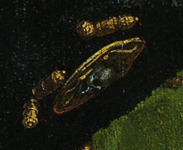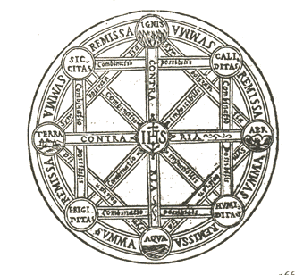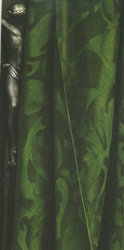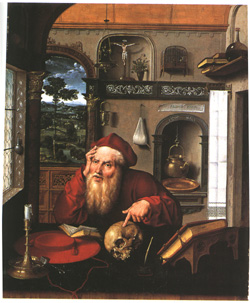

The Skull

The inclusion of the skull makes explicit the essential finiteness of man and
the limitation of human knowledge. A skull also appears as a badge on Dinteville's cap. As a traditional vanitas symbol, the
skull functions as reminder of human finiteness, subject to time and ending
in death. The choice of an anamorphic representation of the skull reinforces
this theme of human limitation. Here Holbein seems
to be opposing human vision, as a metaphor for understanding, to that of God.
Human vision and knowledge are necessarily limited by time and place, while God
can see and know all things at all times. In viewing the work we can see either
the painting with all the objects pertaining to empirical observation:
A skull also appears as a badge on Dinteville's cap. As a traditional vanitas symbol, the
skull functions as reminder of human finiteness, subject to time and ending
in death. The choice of an anamorphic representation of the skull reinforces
this theme of human limitation. Here Holbein seems
to be opposing human vision, as a metaphor for understanding, to that of God.
Human vision and knowledge are necessarily limited by time and place, while God
can see and know all things at all times. In viewing the work we can see either
the painting with all the objects pertaining to empirical observation:

or the skull, with its implications of cancellation and transcendence of temporal existence:
but not both at the same time.
The contrast between human vision and that of God is stated in the following passage from Nicholas of Cusa's Vision of God:
Your eye, Lord reaches to all things without turning. When our eye turns itself toward an object it is because our sight sees but through a finite angle. But the angle of Your eye, O God, is not limited, but is infinite, being the angle of a circle, nay of an infinite sphere, since your sight is an eye of sphericity and of infinite perfection. Wherefore it sees at one and the same time all things above and below.*
The cancellation of the rest of the painting in encountering the anamorphic skull can be connected to the contrast between discursive reason and intellectual vision as different stages of human knowledge. Like God in visio intellectualis, the skull "...is encountered --unlike any other existing thing-- ignorantly, or unintelligibly in a shadow or in darkness or unknowingly."*
Holbein's placement of the skull in relationship to the floor seems to be intentional: the skull covers the center of the floor design, the center of the macrocosm. We should understand this center as signifying God, who is the absolute center of the world. Nicholas of Cusa observes:
Precise equidistance to different things cannot be found except in the case of God, because God alone is Infinite Equality. Therefore, He who is the center of the world, vis., the Blessed God, is also the center of the earth, of all spheres, and of all things in the world. *
That the center of the macrocosm diagram would be understood as signifying divinity is suggested by the adaptation by Christopher Clavius* of Oronce Finé's macrocosm diagram:

The only change made by Clavius is to insert the initials I H S in the center of the diagram.
Thus in the syntax of the painting, we should read the positioning of the skull in relationship to the center of the floor as signifying how human mortality obscures a true vision of God.

The assertive placement of Dinteville's right foot in the center of one of the circles of the floor pattern suggests that man too is a center, but he is a relative center and not the absolute center. Nicholas of Cusa writes:
Human activity consists in unfolding everything beyond itself into its own circular field, in making everything come forth from the virtuality of the center.*
In his dialogue Idiota de mente, Cusa characterizes the human mind as a "living compass" (circinus vivus) which measures all things.*
In contrast to Dinteville's feet, de Selve's feet, hidden by his gown, are placed indeterminately in relationship to the floor. This ambiguous positioning of de Selve possibly alludes to his functions as a cleric and an emissary, caught between the spiritual and temporal spheres.
The skull should also be seen in relationship to the half-hidden crucifix in the upper left corner:

It has been noted by others that the pairing in The Ambassadors of the skull with the crucifix echoes early sixteenth-century images of St. Jerome in his Study.* Probably the best known example is Albrecht Dürer's 1513 engraving:

The association of the skull and crucifix is made more important when we examine the print from the perspective of Jerome. If he were to look up at the crucifix he would see a profile view of the skull directly behind it.
Joos van Cleve's painting from about 1525 of the same subject pairs the skull and crucifix through the central axis:

The skull in association with the crucifix brings to mind Golgotha ( golgotha is the Hebrew word for skull) or Calvary (calvaria is the Latin word for skull). According to tradition, it was on this hill that Adam was buried. Thus the blood of Christ's passion cleanses the sin of Adam, an idea visually expressed by the regular appearance of the skull at the foot of the Cross in traditional images of the Crucifixion.
In the context of the St . Jerome in his Study images, Jerome serves as the model of the Christian scholar whose life dedicated to lectio divina makes him profoundly aware of human mortality and the necessity of Christ's passion as the only means to victory over death.* The transience of human existence is regularly brought out in the Jerome images by symbols like the candle and the hourglass. In The Ambassadors , the astronomical instruments on the top shelf likewise bring to mind the contrast between our temporal existence and the eternal life through Christ's Passion.
